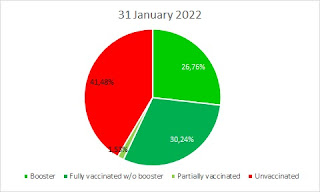Monday, 14 February 2022
Omicron
now accounts for more than 90% of sequences. To make stats less boring, time to
come up with the distinction between BA.1 (current prevalent) and BA.2 (less
than 5% of sequences these days) – more infectious and probably more deadly
subvariant which already prevails in Denmark.
Tuesday, 15 February 2022
After the post-contact quarantine was lifted and less than a week before pupils
return to classrooms, headmaster still do not know how to handle groups where
one pupil or a teacher has been tested positive. Until recently, in such cases
remote learning was compulsory. As of now, the regulations are unclear. In
early March schools might become a hotbed of the virus again, as the wave has
not burnt out naturally and the level of immunisation is not particularly high.
Wednesday, 16 February 2022
The 7-day average of new infections decreases below 30,000, after staying above
such level for 22 days.
Thursday, 17 February 2022
75% of Warsaw’s residents fully vaccinated. The figure looks well, but with
respect to curbing transmission, is useless. With respect to preventing severe
course of the illness and death, vaccines still prove good, decreasing those
risk by around 8 to 9 times in all age groups.
Friday, 18 February 2022
The 7-day average of new infections decreases below 25,000, after staying above
such level for 27 days. The fifth wave declines as quickly as it inclined.
The 7-day average number of deaths peaks out at 251 in Poland; 4 fewer and
exactly on the day predicted by MOCOS in the first week of February.
Saturday, 19 February 2022
Sunday, 20 February 2022
Queen Elisabeth (aged 95) tested positive for COVID-19. The British queen has been triple-vaccinated (date of booster jab unknown) and is reported to have only mild symptoms. Hope she continues to feel well.
Monday, 21 February 2022
It seems that school closure on 27 January brought forward the peak in infection by one week. Nevertheless, if this wave does not burn out as it should naturally, I expect a rebound, or levelling off in early March, a few days after today’s school reopening.
Tuesday, 22 February 2022
In Iceland, more than 10% of population are active cases. Neither in Slovenia, nor in Denmark more than 10% were not isolated when inflections peak. Iceland is a quaint and only example of a country where infections have kept rising for the recent two months. The well-vaccinated nation sees however, a single-digit number of critical cases (2 out of around 35,000 in total) and reports on average less than 1 death daily.
Wednesday, 23 February 2022
The 7-day average of new infections decreases below 20,000, after staying above since 20 January. It kept ascending for 13 days, but descended for 21 days.
The Polish prime minister announces all restrictions, except for isolation, quarantine for flatmates and mask-wearing indoors obligation will be lifted as of 1 March.
Thursday, 24 February 2022
Ukraine reports 25,789 new coronavirus cases and 276 new deaths. This is the last COVID-19 report from the country.
Friday, 25 February 2022
Worth looking at South Africa, the first country which experienced a surge of infections caused by omicron. New cases (7-day average) peaked there on 17 December 2021 at 23,437, but unlike in previous waves when deaths peaked out some two weeks after infections, this time deaths kept rising until 19 February 2022 when 7-day average of new deaths reached 233. Any explanation for that?
Saturday, 26 February 2022
R(t) in Poland bottoms out at 0.67. School opening will do its bit soon.





